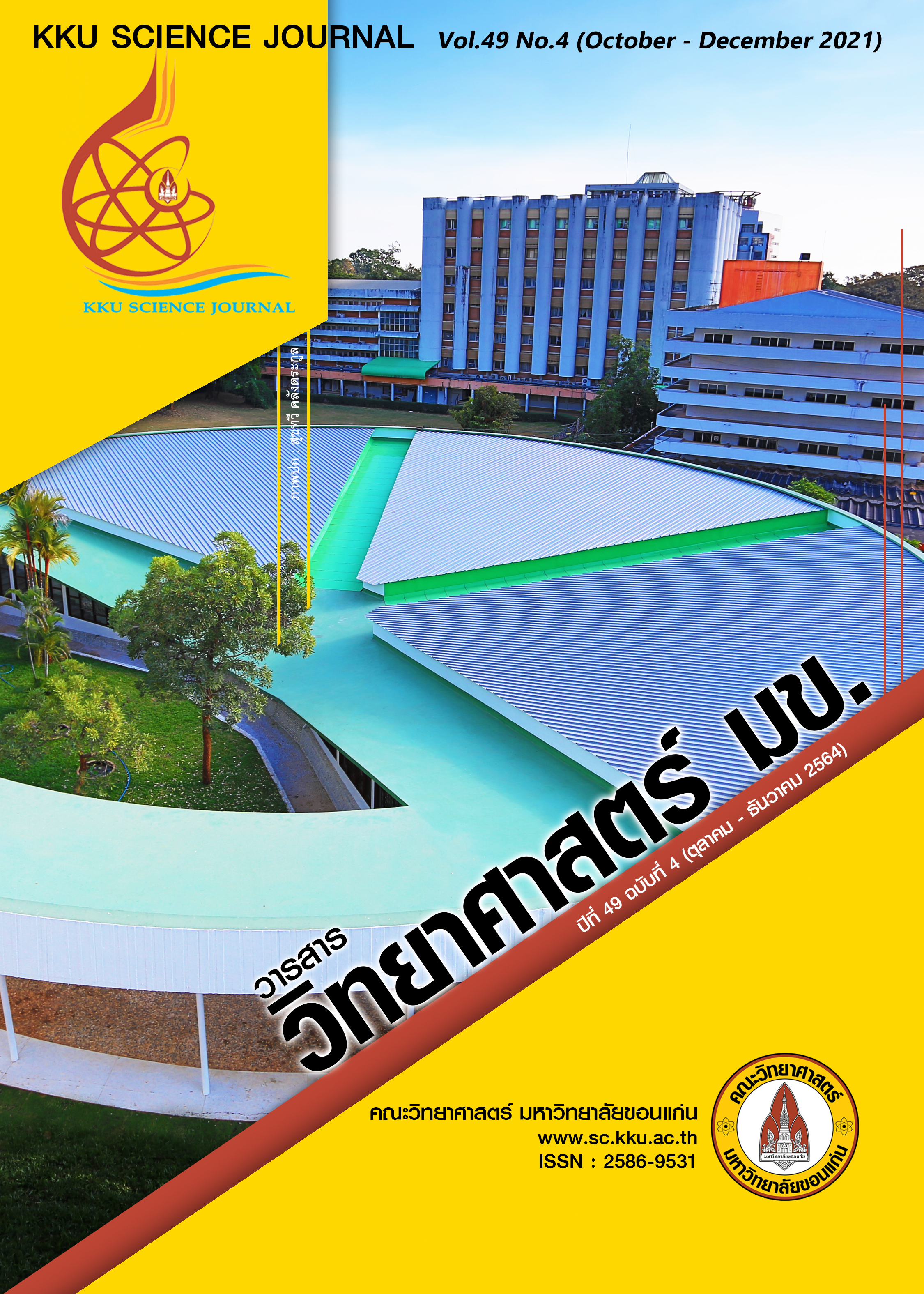Morphological Variation of Wedge Clam (Donax faba Gmelin, 1791) and some Environmental Factors at Bang Hoi Beach and Bang Ruea Nak Beach, Songkhla Province
Main Article Content
Abstract
Wedge Clam (Donax faba Gmelin, 1791) is bivalve which found along the coastal beach. It is a traditional food in local community, diverse in shell characteristics and little of data on its morphological variation, especially at Singhanakorn district, Songkhla province. Then the D. faba were collected between June to August 2020 from 4 stations to study the morphology and some environmental factors within its habitats. The results showed that there were 8 patterns of shell at Bang Hoi Beach and Bang Ruea Nak Beach. Colors and patterns of shells in form F which were yellowish to reddish brown with horizontal lines, radial purple and yellowish brown lines from shell apex was the most common. The average shell size was 21.99±2.37 mm in width, 14.04±1.94 mm in height and average weight was 1.85±0.61 g. Soil and water temperature, pH and salinity were quite similar in study area. The organic content ranged from 0.01 – 0.21% and the sandy beach mainly consisting of fine to very coarse sand particles. When comparing the shell size of D. faba between 8 types, it was found that the mean shell width and weight were not significantly different, while the mean shell height was differently (p<0.05). Eight forms of D. faba were found in all stations in difference proportion, the largest size of them were found at Bang Ruea Nak Beach in August. This can be suggested that the variation on some environmental factors in station and each time periods, especially the particle size and organic content may be influence to the morphological variation of D. faba.
Article Details

This work is licensed under a Creative Commons Attribution-NonCommercial-NoDerivatives 4.0 International License.
References
กรมทรัพยากรทางทะเลและชายฝั่ง. (2556). สัณฐานชายฝั่งทะเลไทย. แหล่งข้อมูล: https://km.dmcr.go.th/th/c_56/s_77/d_2766. ค้นเมื่อวันที่ 16 กุมภาพันธ์ 2564.
เกื้อ ฤทธิบูรณ์ สุภาพร ฝั่งชลจิตต์ พิมลรัตน์ ทองโรย เชาวพจน์ ชววงศ์ษา และสมศักดิ์ บัวทิพย์. (2562). นิเวศวิทยาบางประการของหอยเสียบ (Donax faba Gmelin, 1791) บริเวณหาดบางหลิง อำเภอเทพา จังหวัดสงขลา. วารสารวิทยาศาสตร์บูรพา 24 (1): 395 – 414.
ณัฐวุฒิ ธานี สุวิทย์ จิตรภักดี และขวัญตา ตันติกาธน. (2558). การประเมินคุณภาพชายหาดจังหวัดกระบี่ ตรัง และสตูล โดยใช้สัตว์หน้าดินขนาดใหญ่. รายงานผลการวิจัย. นครราชสีมา: มหาวิทยาลัยเทคโนโลยีสุรนารี.
วาริก เส็นนาฮู อัครเดช แหลมกา และสุธินี หีมยิ. (2560). ประชาคมสัตว์หน้าดินขนาดกลางบริเวณหาดสะกอม จังหวัดสงขลา. วารสารวิจัยเทคโนโลยีการประมง 11(1): 93 – 105.
ศักดิ์อนันต์ ปลาทอง จินตนา ปลาทอง และปัทมาภรณ์ หมาดนุ้ย. (2556). คู่มือการจัดทำกิจกรรมการเรียนรู้ระบบนิเวศทางทะเลและชายฝั่ง ระบบนิเวศหาดทรายเกาะเต่า จังหวัดสุราษฎร์ธานี. (พิมพ์ครั้งที่ 1). กรุงเทพมหานคร: โรงพิมพ์โอ เอส พริ้นติ้ง เฮ้าส์ จำกัด. หน้า 1 – 77.
Huz, R.D.L., Lastra, M. and Lopez, J. (2002). The influence of sediment grain size on burrowing, growth and metabolism of Donax trunculus L. (Bivalvia: Donacidae). Journal of Sea Research
(2): 85 – 95.
Kenny, A.J. and Sotheran, I. (2013). Characterising the physical properties of seabed habitats. In Methods for the Study of Marine Benthos. Oxford: Wiley Blackwell, pp. 47 – 96.
Lin L.Y. (2 0 1 9). Umbonium vestiarium (Vestigastropoda :Trochidae) Button snail. Biodiversity. แหล่งข้อมูล: https://wiki.nus.edu.sg/display/TAX/LSM4254++. ค้นเมื่อวันที่ 20 มีนาคม 2564.
Manatrinon, S., Thonglor, O. and Boonyapakdee, A. (2012). Genetic and morphological variation in three populations of Donax spp. in the Gulf of Thailand. Thai Journal of Genetics 5(1): 79 – 88.
Nelson, D.W. and Sommers, L.E. (1982). Total carbon, organic carbon and organic matter. In Method of Soil Analysis, Part 2, Chemical and Microbiological Properties. Wisconsin: American Society of Agronomy, Inc. and Soil Science Society of America. Inc. pp. 539 – 579.
Signorelli, J.H. and Printrakoon, C. (2019). The family Donacidae (Bivalvia: Tellinoidea) in Thai waters. Molluscan Research 40(3): 8 – 35.
Snelgrove, P.V.R. and Butman, C.A. (1994). Animal sediment relationships revisited – cause versus effect. Oceanography and Marine Biology 32: 111 – 177.
Swennen, C., Moolenbeek, R.G., Ruttanadakul, N., Hobbelink, H., Dekker, H. and Hajisamae, S. (2001). The molluscs of the southern Gulf of Thailland. Bangkok: Biodiversity Research and Training Program. pp. 1 – 210.
Tan, S.K. and Low, M.E.Y. (2013). Singapore Mollusca: 3. The family Donacidae (Bivalvia: Veneroida: Tellinoidea). Nature in Singapore 6: 257 – 263.
Tenjing, S.Y. (2017). Biometric relationships of edible wedge clam, Donax faba (Gmelin, 1791) from two populations, Panambur (polluted area) and Padukere (unpolluted area) with reference to environmental parameters (India). Vie et Milieu-Life and Environment 67(3-4): 179 – 192


